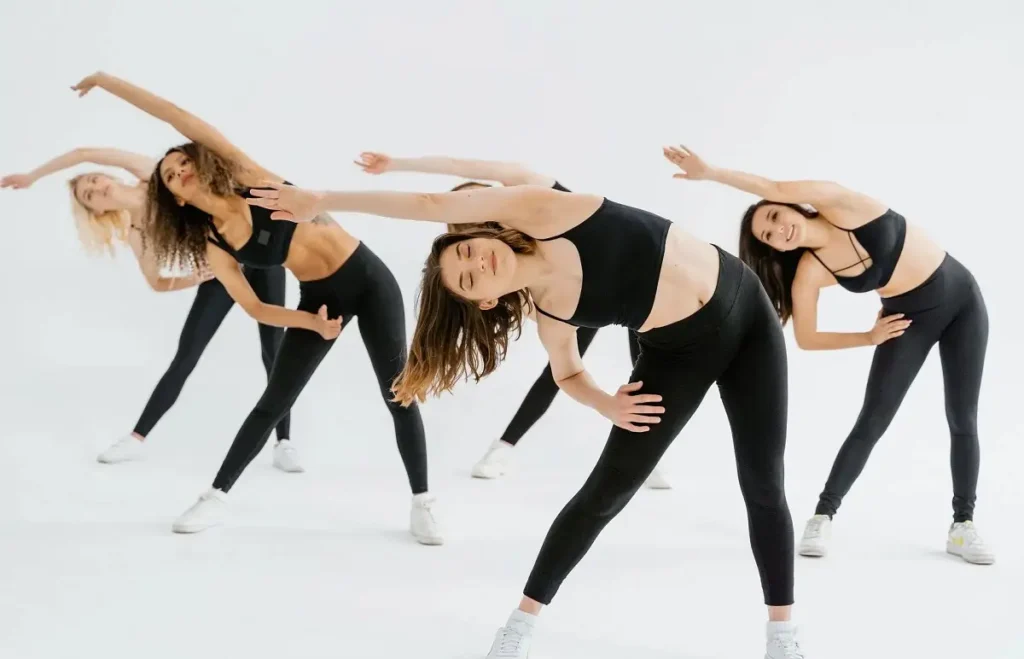Standing Pilates workouts are a great way to improve your balance, posture, and overall strength without needing any equipment. These workouts typically involve a series of exercises that target different muscle groups, focusing on form and control.
What is standing pilates?
Standing Pilates is a form of Pilates that focuses on performing exercises while standing, rather than on the floor or mat. It combines traditional Pilates principles—such as controlled movements, core engagement, and proper breathing—with the added challenge of balance and stability that standing positions require. This approach offers several benefits and can be a great addition to your fitness routine.
Standing Pilates key advantages
- Full Body Engagement: Standing Pilates exercises target multiple muscle groups, including the legs, glutes, core, and arms. This helps in building overall strength and stability.
- Balance and Coordination: Since you’re performing the exercises while standing, it challenges your balance and coordination, which can be beneficial for everyday activities.
- Low Impact: These workouts are low impact, making them suitable for people of all fitness levels, including those with joint issues.
- No Equipment Needed: You can do these workouts anywhere since they don’t require any special equipment.
Are you looking for a low-impact workout that strengthens your body, improves balance, and enhances flexibility? Standing Pilates might be just what you need! This form of exercise is perfect for beginners and can be done anywhere without any special equipment.
Here are some beginner-friendly standing Pilates moves to help you get started on your fitness journey.
1. Standing Roll Down
How to Do It:
- Stand tall with your feet hip-width apart.
- Slowly roll down, vertebra by vertebra, reaching towards your toes.
- Roll back up to standing, engaging your core throughout the movement.
Benefits: This move helps to stretch your spine, improve flexibility, and engage your core muscles.
2. Standing Leg Lift
How to Do It:
- Stand with your feet together and hands on your hips.
- Lift one leg to the side, keeping it straight.
- Lower it back down and repeat on the other side.
Benefits: Standing leg lifts strengthen your glutes, hips, and outer thighs while improving balance.
3. Standing Side Bend
How to Do It:
- Stand with your feet hip-width apart and arms by your sides.
- Reach one arm overhead and bend to the opposite side.
- Return to center and repeat on the other side.
Benefits: This exercise stretches the sides of your body, improves flexibility, and engages your oblique muscles.
4. Standing Arm Circles
How to Do It:
- Stand with your feet hip-width apart and arms extended to the sides.
- Make small circles with your arms, gradually increasing the size.
- Reverse the direction after a few circles.
Benefits: Arm circles help to tone your shoulders and arms while improving shoulder mobility.
5. Standing March
How to Do It:
- Stand with your feet hip-width apart.
- Lift one knee towards your chest, then lower it back down.
- Alternate legs in a marching motion.
Benefits: This move engages your core, improves coordination, and gets your heart rate up.
Tips for Success
- Use small props: Standing Pilates often requires little to no equipment, but sometimes small props like light hand weights, a Pilates ring, or a chair for support might be used.
- Focus on Breathing: Inhale through your nose and exhale through your mouth, coordinating your breath with your movements.
- Engage Your Core: Keep your abdominal muscles engaged to support your spine and improve stability.
- Maintain Good Posture: Stand tall with your shoulders relaxed and back straight.
Conclusion
Standing Pilates is a fantastic way to build strength, improve balance, and enhance flexibility without putting stress on your joints. These beginner-friendly moves are a great starting point for anyone new to Pilates. Remember to listen to your body and progress at your own pace. Happy exercising!
